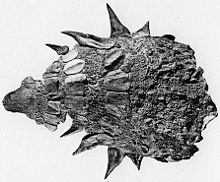- Edmontonia
-
Edmontonia
Temporal range: Late Cretaceous, 76.5–65.5 Ma
Mounted skeleton Scientific classification 
Kingdom: Animalia Phylum: Chordata Class: Reptilia Superorder: Dinosauria Order: †Ornithischia Family: †Nodosauridae Genus: †Edmontonia
Sternberg, 1928Species - E. longiceps Sternberg, 1928 (type)
- E. rugosidens (Gilmore, 1930 [originally Palaeoscincus rugosidens])
- E. schlessmani (Bakker, 1988 [originally Denversaurus schlessmani])
Synonyms - Denversaurus Bakker, 1988
Edmontonia was an armoured dinosaur, a part of the nodosaur family from the Late Cretaceous Period. It is named after the Edmonton Formation (now the Horseshoe Canyon Formation), the unit of rock it was found in.
Contents
Description
Edmontonia was bulky and tank-like at roughly 6.6 m (22 ft)[1] long and 2 m (6 ft) high.[citation needed] It had small, ridged bony plates on its back and head and many sharp spikes along its back and tail. The four largest spikes jutted out from the shoulders on each side, two of which were split into subspines in some specimens.[1] Its skull had a pear-like shape when viewed from above.[1] (Compare 26 feet long and 8 feet high for the M1 Abrams army tank.)
Discovery and species
The type species of Edmontonia, E. longiceps was discovered in 1924 by George Paterson. It wasn't named until 1928 by C. M. Sternberg. E. rugosidens, formally named by Gilmore in 1930, is reported from the Aguja formation in Texas. Edmontonia species include:
- E. longiceps, the type), is known from the middle Horseshoe Canyon Formation (Unit 2) dated to 71.5-71 million years ago.[2]
- E. rugosidens, is sometimes given its own genus, Chassternbergia, first coined as a subgenus by Dr. Robert T. Bakker in 1988 (Edmontonia (Chassternbergia) rugosidens) and based on differences in skull proportion from E. longiceps and its earlier time period.[3][4] This subgenus or genus is not generally accepted;[5][6] It is found in the lower Dinosaur Park Formation, dating about 76.5-75 million years ago.[2]
- And E. australis,[4] which is known from cervical scutes only, and is considered to be a dubious name[5] or a synonym of Glyptodontopelta mimus.[7]
Usually included in this genus is Denversaurus schlessmani ("Schlessman's Denver lizard"). This taxon was erected by Bakker in 1988 for a skull from the Late Maastrichtian Upper Cretaceous Lance Formation of South Dakota,[3] but considered by later workers to belong to Edmontonia rugosidens.[6] The type specimen of Denversaurus is in the collections of the Denver Museum of Natural History (now the Denver Museum of Nature and Science), Denver, Colorado (for which the genus was named).
Paleobiology
The large spikes were probably used between males in contests of strength to defend territory or gain mates.[1] The spikes would also have been useful for intimidating predators or rival males, protection, or for self-defense.[1] To protect itself from predators, an Edmontonia might have crouched down on the ground to minimize the possibility of attack to its defenseless underbelly.
Rings in the petrified wood of trees contemporary with Edmontonia show evidence of strong seasonal changes in precipitation and temperature;[1] this may hold an explanation for why so many specimens have been found with their armor plating and spikes in the same position they were in life.[1] The Edmontonia could have died due to drought, dried up, and then rapidly became covered in sediment when the rainy season began.[1]
References
- ^ a b c d e f g h "Edmontonia." In: Dodson, Peter & Britt, Brooks & Carpenter, Kenneth & Forster, Catherine A. & Gillette, David D. & Norell, Mark A. & Olshevsky, George & Parrish, J. Michael & Weishampel, David B. The Age of Dinosaurs. Publications International, LTD. p. 141. ISBN 0-7853-0443-6.
- ^ a b Arbour, V. M.; Burns, M. E.; and Sissons, R. L. (2009). "A redescription of the ankylosaurid dinosaur Dyoplosaurus acutosquameus Parks, 1924 (Ornithischia: Ankylosauria) and a revision of the genus". Journal of Vertebrate Paleontology 29 (4): 1117–1135. doi:10.1671/039.029.0405.
- ^ a b Bakker, R.T. (1988). Review of the Late Cretaceous nodosauroid Dinosauria: Denversaurus schlessmani, a new armor-plated dinosaur from the Latest Cretaceous of South Dakota, the last survivor of the nodosaurians, with comments on Stegosaur-Nodosaur relationships. Hunteria 1(3):1-23.(1988).
- ^ a b Ford, T.L. (2000). A review of ankylosaur osteoderms from New Mexico and a preliminary review of ankylosaur armor. In: Lucas, S.G., and Heckert, A.B. (eds.). Dinosaurs of New Mexico. New Mexico Museum of Natural History and Science Bulletin 17:157-176.
- ^ a b Carpenter K (2001). "Phylogenetic analysis of the Ankylosauria". In Carpenter, Kenneth(ed). The Armored Dinosaurs. Indiana University Press. pp. 455–484. ISBN 0-253-33964-2.
- ^ a b Vickaryous, M.K., Maryańska, T., and Weishampel, D.B., (2004). "Ankylosauria". In Weishampel, D. B., Dodson, P., and Osmólska, H. (eds.). The Dinosauria (Second Edition). University of California Press. pp. 363–392. ISBN 0-520-24209-2.
- ^ Burns, Michael E. (2008). "Taxonomic utility of ankylosaur (Dinosauria, Ornithischia) osteoderms: Glyptodontopelta mimus Ford, 2000: a test case". Journal of Vertebrate Paleontology 28 (4): 1102–1109. doi:10.1671/0272-4634-28.4.1102.
Categories:- Cretaceous dinosaurs
- Dinosaurs of North America
- Ankylosaurs
Wikimedia Foundation. 2010.




